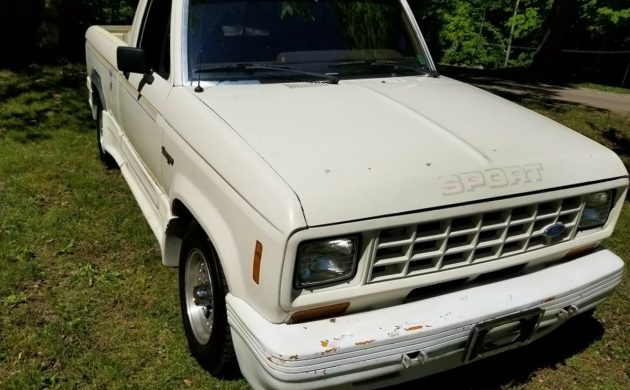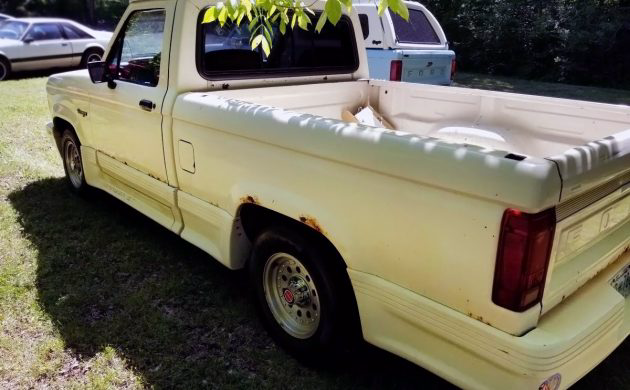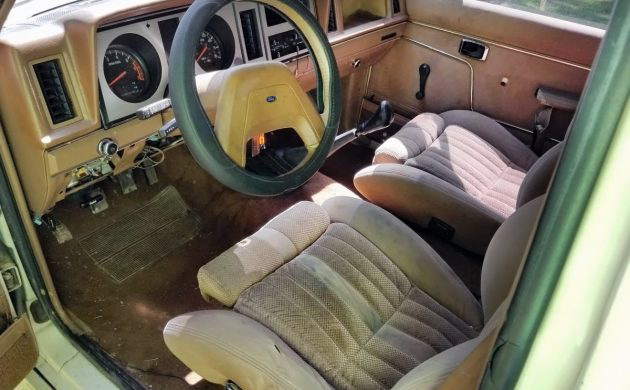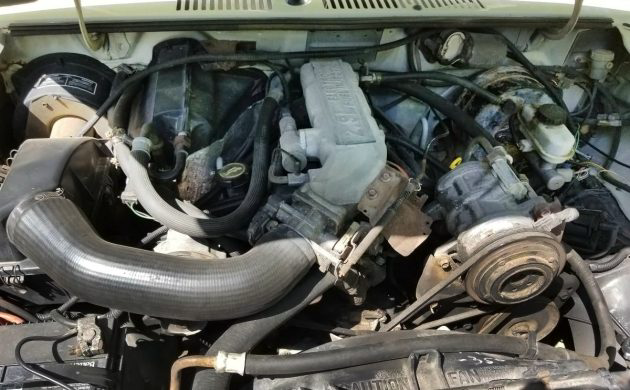We show a fair amount of small pickups here but since US companies didn’t really offer small pickups until the early-80s, at least of a homegrown variety, most of them have been rebadged Japanese offerings. This 1988 Ford Ranger GT is a rare version of this well-known pickup and it can be found here on craigslist in Nashville, Tennessee. The seller is asking $1,850 or best offer.
3, 2, 1… I’m just counting off the seconds until someone proves me wrong on a domestic auto maker offering a mass-produced small pickup made in America for the US market. I’m not talking about a Crosley or a Falcon Ranchero, etc., or a rebadged foreign truck. I mean what we know today as a reliable, daily-usable pickup with the modern features and safety and reliability that we have come to know and love about our trucks. I can’t think of one before the Chevy S10 and Ranger, can you?
The Ranger GT is a fairly rare unit as they were made only for the 1988 and 1989 model years. They don’t come up for sale too often and when they do, my eyes perk up. Or is that my ears? I don’t see with my ears.. hmm.. Anyway, I take notice. I like as rust-free of a vehicle as I can find, though, and you can see rust lurking on this example and what looks like rust repairs?. The seller says that it’s “Original it has spent a lot of its life being towed by A RV It does have some small rust spots but nothing major”. The GT package added around $4,600 to the price of a Ranger which is around $9,700 in today’s dollars.
The interior is interesting and those should be the factory seats which the seller refers to as Recaro seats. I don’t believe that they’re actual Recaro brand seats but they are sport seats and they should have power lumbar support. This GT comes with a 5-speed manual transmission but a 4-speed automatic was an option. It seems like most of the examples that I have seen have had a fat steering wheel cover for some reason. This truck needs work for sure but they are unique rides.
Here’s the 2.9 V6 which would have had around 140 hp so it’s nice to have a 5-speed manual transmission to be able wring those ponies out as much as possible. This Ranger GT is rare with fewer than 2,000 of them being made between 1988 and 1989 and this one “runs and drives very well”. I would sure like to add one of these to the herd someday. Have any of you owned a Ranger GT?







“I’m just counting off the seconds until someone proves me wrong on a domestic auto maker offering a mass-produced small pickup made in America for the US market.”
A “domestic automaker” in this case would mean a company that makes vehicles in the US for US sales.
On semantics, the Volkswagen Rabbit pickup was made in the US for Sales in the US beginning in 1978.
I can think of one….the Studebaker Champ. Used the same front end sheetmetal as the compact Lark.
How about the I-H Scout or first-gen Bronco with a half cab? I’d call both of those “compact pickups”.
I owed one of these. Quick trucks, and handled like they were on rails. The fatter anti-sway bars made a world of difference. This one is in sad shape. Under that body cladding is all rusted up. Its pretty common for these trucks.
A Ranger Sport (whistles), who was sportin’ that kind of cash? I hate catchy sayings used by politicians, but the “lipstick on a pig” thing seems to apply here. The Ranger was a good truck, but sporty? Hardly. I never cared for that V6. I never thought I’d say this, but history has shown, the 2.3 was a much better engine. The plastic panels look silly, and it was no sport truck, just a good little hauler.
And for the record, America did make a small pickup in the early ’80’s, the often forgotten 1982-84 Dodge Rampage (or Plymouth Scamp). It remains the only American front-wheel drive pickup ever made. ( I know about the VW made here, it was still a VW)
Another example of the utter contempt the Big Three had for the car-buying public. When the truck was brand new I will bet the “ground effects” still looked like a cheap aluminum siding project. And let’s add a “Sport” decal or two for good measure. Big Three management should have been forced to drive the junk they were responsible for.
I know this post is over a year old but reading this comment makes me cringe. Its obvious you didn’t own one. The plastic on the ground effects was a rubbery plastic and held up well to all sorts of punishment from me. The “decals” you said were not decals at all. In every case I ran into, all graphics were painted on – including mine. In an era of bad cars, I would argue that this was not one of them. I drove mine hard and fast – running very close to mustang’s at the time. I had very few issues with it and wish I had never sold it. I can’t say the same for the 20+ other cars I’ve had…
The Chevy Luv? No idea where those were made, but I like to be part of a discussion.
Hey, guys. I should have been a little more clear, I was thinking of a small pickup like a Toyota/Datsun/Mazda/etc. Not a car-based Falcon-like car-pickup but a small truck that was made as a small truck and that’s it, for the US in the US. A small American-made, American-based company small pickup like the Chevy S10 (1982) or Ford Ranger (1983).
Does that make more sense? A Chevy LUV was a rebadged Isuzu so that wouldn’t work. A Studebaker wasn’t a small truck like a Ranger or S10. A Scout or Bronco with half-cab wasn’t a purpose-built, as in only a small pickup truck like a Ranger or S10 was, but I’d love to have one of each! Of course, VW is a German company, but I love how you’re thinking outside the box on American-made in America, eggsalad! But, it was a car-based pickup not what we think of as a small pickup today, like a Ranger.
Howard, I was thinking of a pickup-pickup, not a car-based pickup conversion like a Falcon or El Camino sort of thing.
Keep trying, there has to be one! Think of a Toyota/Datsun/Mazda/Isuzu competitor in the small pickup arena but mass-produced by an American company. I literally can’t think of one before the Chevy S10 in 1982 but there had to have been one.
How about the Chevy Luv?
Or not enough doo – dads to
actively qualify? 🤔
The first series Jeep. The service station down the block had one. It also had a PTO to power a snowblower, roto tiller, a big water pump for fire duty.
This critter also pulled a plow and cultivator. Albeit the Jeep probably doesn’t for your question, but the dimensions of the small truck was mimiced by the man-yo-facturers. Long before the ‘pickup based cars’ that now cost $65K or more.
Crosley? Not sure their pick up trucks from the 1940s-50s were produced in large enough quantities to be called “mass” produced though.
I think you have not driven a Studebaker Champ. It is not a full size PU.
So I think you need to include the Champ.
I agree with Howard. The 2.3 is the engine to have in one of these.
They also can corner quite well. Think about it, with the twin-i-beam front suspension. When the truck leans into a corner the outside tire goes negative camber. I have a distinct dislike for the twin-i-beam front suspension (excessive tire wear and bump steer) but driven properly you can push them (2WD only) pretty hard through a corner. Ask my wife, she will claim that she has left dents on the inside of the doors from getting pushed had against the door from my driving style.
Around 1963-66 Chevrolet Ford, Dodge?? Manufactured cab over engine / cab forward light duty pickups that looked like a van cut off behind the driver’s and passengers seat and about a six foot fleetside bed. Different than the c/k, f, w series offerings of the time.
Earlier today I was enjoying a cold one on the patio at the local Legion when a lady was having trouble starting her early generation Ranger when my friend ( We”ll call him Dale) cause that’s his name.,went over to help. Got her started & on her way. Came back & proudly announced it’s a problem with the fuel pump. Two hours later I’m sitting at home at the picnic table facing the park next door. I look up from my beer & reading to see Dale trying to get a very large shepherd off his rump. I yelled ‘Dale I think it’s the fuel pump’.
Sorry, My edit turned into a double post.
Hmm. Huh? 1980s Ranger pickups had “Twin I Beam?” I don’t think that catchphrase was ever used with the compact Rangers. Maybe the badged Rangers from a few years before.
Alexander, evidently you have never been underneath a Ranger built from 1983 to 1997 or 1998. They all had twin-I-beam front suspension. (The 4X4s used a mini F150 split front style axle set up that is similar to the ’60s style rear axle set-up like Mercedes used.) The 4X4 set up has all the similarities as the twin-I-beam only amplify the bad qualities because of using shorter axle length. Using this front suspension on 4X4 and a short wheelbase is why so many Bronco IIs ended up on their roofs or sides. (high center of gravity and front wheels that like to “tuck under” ) Being an Ex-Ford parts manager meant that I had to stock at least a couple of roof panels all the time. (That suspension set up made quite a few mortgage payments for me. Thank you Ford!) In 1998 or 1997 they went to “A” arm style front suspension . The 2WD used coil springs and the 4X4 used torsion bar.
If you don’t have a Ranger to crawl under. Look up “lowering kits” for a 1988 2wd Ranger on the Summit website. You will see a pair of modified twin-I-beams. Twin-I-Beam was a good idea for a strong, low maintenance front suspension. However it eats front tires. (Think of a tire that does not move vertically up and down with pavement undulations and bumps. But rather swings at an arch. Very tough on inside and outside tire shoulder wear. Ask anyone that has been in the tire business for any length of time And they will verify the fact that a vehicle with this front suspension will wear front tires at a rate of about twice as fast as one with “normal” front suspension. This wear is accelerated on a vehicle that is loaded heavily. (back end sagging) This condition was really bad on Econoline extended 15 passenger vans. (where Ford just tacked on an extension behind the rear wheels) The rear of the vehicle sagged badly causing the front tires to run in a very positive camber position. So when one of these vans blows a rear tire. The driver is at a disadvantage trying to control the vehicle as the front tires only have about 1/3 the front tire contact patch because of the vehicle attitude. Plus all the weight is transferred to the rear even before the blow-out! And this is why we now have additional roll over protection requirements for passenger vans. (Yes Dodge did the same thing as far as extending their vans. But at least they had a reasonable front suspension for better control.)
Also having sold commercial vehicles. I have seen studies done by leasing companies as far as actual cost of ownership. The Econoline started out cheaper. (initial cost) The fuel costs were virtually identical. But once the mileage starts to approach 100K, the GM vehicles jumped into the lead on overall costs. (less cost) This was strictly due to 4 to 6 less pairs of tires. And then at the end of the vehicles life (Lease over) the GM vehicle had more resale value. (about $800) So to recap, The Ford had a $800 cheaper initial cost and ended up costing the lease company/owner more money for the extra tires. At that point the total cost was about the same. But at the end of the lease the residual was less because of the lower resale value.
Ok, ok, enough for the twin-I-beam lesson for the day. I am sure that this is way more than you wanted to hear.
I will now return to my rubber walled room.
You share a lot of good info but it’s clear that your opinion is effecting your overall judgement. The TIB and TTB are indeed known for causing premature tire wear; however this is only true when a suspension lift is applied. Specifically a lift that is just on the coil springs. At this point the inner tie rods connecting to the pitman arm create a tighter angled triangle. This in turn creates an inward pulling force on the outer tie rod ends subsequently leading to positive camber and finally the tire wear you described in detail. With this simple change in geometry the solution is obvious- a pitman arm suitable for a small lift. This would drop the tie rods back to OEM angles and cancel out the camber change. The TIB has been around for decades. It began on the early ford pickups as a stronger form of an independent front suspension with less linkages and fewer pivot points to watch for. On the 4×4’s it was almost as if they had taken a solid front axle and found a way to cut it in half. The result was a softer ride, more suitable ride at the cost of front suspension travel and of course strength compared to a solid axle. Many people hate fords unique TIB/TTB because when they venture into the aftermarket to change lift or drop the front end they are met with bump steer, positive camber and wheel and suspension wear. However with a littleness understanding of geometry the issues can be avoided. I’ve driven my 1995 2wd ford ranger for 10 years on two sets of tires. Neither of which ever experienced any uneven or abnormal tire wear.
I bought one used had it about two years. It was a good truck for really light duty hauling. Other than the cool looks I didn’t think it was really all that.
The GT was made in 86 an 87 as well but without the ground effects. I had an 86. They were built for the new SCCA Sportruck race series and the civilian versions had the V6 whereas the race versions were the 2.3 I4. I put 386K miles on mine before I sold it to another enthusiast. The only serious problem I ever had with it was the ignition module, which was bolted to the distributor would burn out every 100K miles or so.
Karl
My husband purchased the 88 Ford Ranger GT out of the showroom as his toy. He’s only put 88k miles on it. Fortunately for us, our kids prefer to drive automatics. 🙂
Courier and the Luv maybe? Oh and the d50
Elan, you are mostly correct. The steering angle is comprised when doing a lift and amplifies the issue with the camber. But, turning/steering issues no not change camber. On a related note. On solid axle front suspension like on F250/350s and Dodge/Ram 3/4 ton on up and Jeeps with solid axles. Get a thing called DEATH WOBBLES. The first thing that people do is change the steering stabilizer and track bar because they are worn. And they usually are along with other steering components. These worn parts are usually amplifying another cause. That is usually the lack of positive caster (or in old terms King pin inclination) The lack of positive caster does not cause the wobbles rather it allows them to happen. Then it is amplified by worn parts and big tires. Many a customer has ended upon my business step with receipts for many dollars spent to correct the issue and still having the problem. On vehicles where aftermarket front control arms that are adjustable. The issue can be addressed using the adjustable arms, providing the front axle pinion angle is not blown out of acceptable range. A Dodge/Ram will come in where it has new ball joints installed. Because of age and mileage they were most likely worn. But by installing offset ball joints (normally used to correct camber issues) You can crank in a few degrees of positive caster instead. This issue comes from worn leaf springs, (causing the caster to go negative) bent or stressed axle housing, (as seen on older Dodges with the heavy Cummins engine) or modifications with no regard to caster settings. The other issue can be just worn springs which causes the front end to sag and put additional stress on control arm/leaf spring busings actually causing the front axle to rotate slightly to where the caster is past the point of keeping the steering steady/and “wobble free”. I have never failed to correct “DEARH WOBBLES” . Unfortunately it is after someone has spent a bunch of money. And I end up charging them even more to correct the issue.
I had a Ranger GT in highschool. Coolest little truck ever. I bought mine for $500 bucks in 1998. Drive that thing for almost 10 years. All blacked out, lumbar seats, sunroof, etc. loved that truck.